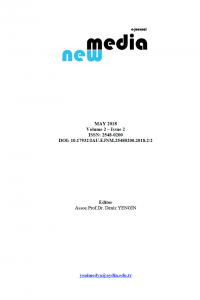Öz
This
article addresses power, ideology and media context generally. .In democratic
countries, the free media is regarded as the “fourth estate” besides the
legislative, executive and judiciary branches. It can be said that political
power has a significant role in shaping media discourse. The newspapers as the
most efficient print media elements have an effective role in media discourse.
Besides determining political agenda, the newspapers function as the instrument
of hegemony of the political authority. The objective of this article is
two-fold. The first is to analyze the role of the media discourse in the
(re)production of ideologies. Within this framework, the role of the media in
democratic countries will also be under scrutiny. Second,a historical overview
of Turkish print media in general and the Hürriyet newspaper in particular will
be provided. Bourdieu argues that, the power of the words lies not in their
intrinsic qualities but in the belief that they are uttered by authorized
spokespersons (Bourdieu, 1991: p.170). In this context, one of the main
arguments of this article is that the Hurriyet newspaper as one of the leading
voices of the mainstream media is efficient in determining the political and
social agenda. The qualitative research method is used in the article.
Anahtar Kelimeler
Kaynakça
- Althusser, L. (1971). Ideology and Ideological State Apparatuses.New York: Monthly Review Press. Bourdieu, P. (1991). Language and Symbolic Power. Cambridge, Mass.: Harvard University Press Burak, B. (2010). Türkiye’nin Siyasal ve Yönetsel Yaşamında 28 Şubat Süreci’nin Yeri Üzerine Bir İnceleme (Master Dissertation, Istanbul University). Duran, R. (2003). Türk Medyası Neden Savaş Yanlısı. Savaş ve Medya. Eskişehir: ILAD. Eagleton, T. (1991). Ideology: An Introduction. London: Verso. Efe, İ. (2012). Critical Discourse Analysis of Kemalism and Islamism in Turkish Newspapers: The 2008 Indictment Case the 28 February National Security Council Meeting (Doctoral Dissertation, Lancaster University). Fairclough, N. L. Wodak .R. (1997). Critical discourse analysis. In, Teun A. V. D.Discourse Studies. A Multidisciplinary Introduction. Vol. 2. Discourse as Social Interaction. London: Sage. 258-284 Fontana, B. (2005). The Democratic Philosopher: Rhetoric as Hegemony in Gramsci, .ItalianCulture.Vol: 23. No: 1. . 97-123. Foucault, M. (1979). Disciplin eand Punish: the Birth of the Prison. Harmondsworth: Penguin Foucault, M. (1984). The Order of Discourse. İn Shapiro, M. Language and Politics. London: Blackwell. 108-138. Gaventa, J. (2003). Power After Lukes: A Review Of TheLiterature. Brighton: Institute of Development Studies Hoare, Q.,Geoffrey, N.S. (1971). Selections from the prison notebooks of Antonio Gramsci.New York: International Publishers. Gurevitch, M.,Levy, M. R. (1985). Mass Communication Review Yearbook. Sage Publications Inc. Habermas, J. (1989). The Structural Transformation of the Public Sphere. Cambridge:PolityPress. Herman, E. S. and Chomsky, N. (1988). Manufacturing Consent: ThePoliticalEconomy of the Mass Media. New York: PantheonBooks. Holmes, S. (1991). Liberal constraints on private power? in Lichtenberg, J. Democracy and theMass Media. Cambridge: Cambridge UniversityPress. 21-65. Kaya, R. Çakmur, B. (2010). Politics and the mass media in Turkey. Turkish Studies. Vol: 11. No:4. 521-537. Keane, J. (1991). The Media and Democracy. Cambridge: PolityPress Lasswell, Harold D. (1948). “The structure and function of communication in society”. in Bryson, L. (ed.). The Communication of Ideas. New York: Harper & Co. Pp. 37-51 Montgomery, M. (1995). An İntroduction To Language AndSociety. London: Routledge. Patrick H, N. (1998). Democratization and MassCommunication: What Is the Link. inO’Neil, Patrick H. Communicating Democracy: The Media &Political Transitions.London: Lynne Rienner Publishers. Özerkan, Ş.(2009). Haber Analizi Ve Arşiv İncelemeleriyle Türkiye'de 9 Gazete. Ankara: Nobel Yayin Somer, M. (2010). Media Values And Democratization: What Unites And What Divides Religious-Conservative And Pro-Secular Elites?.Turkish Studies. Vol:11. 555-577 Thompson, J. B. (1984). Studies in The Theory Of Ideology. Cambridge: Polity Press. Topuz, H. (2003). II. Mahmud'tan Holdinglere Türk Basin Tarihi. İstanbul: Remzi Kitabevi. Torfing, J. (1999). New Theories Of Discourse: Laclau, Mouffe And Zizek. Blackwell Publishing Ltd. Tunç, A. (2010). Mediated Justice: Turkish Newspapers’ Coverage of Controversial Criminal Cases. Turkish Studies. Vol: 11 No:4. 643-661. Wodak, R. (1999). Critical discourse analysis at the end of the 20th century. Research on Language &Social Interaction Vol: 32. No: 1-2 185-193. Wodak, R. Michael, M. (2009). Methods for Critical Discourse Analysis. London: Sage.
Ayrıntılar
| Birincil Dil | İngilizce |
|---|---|
| Konular | İletişim ve Medya Çalışmaları |
| Bölüm | Araştırma Makalesi |
| Yazarlar | |
| Yayımlanma Tarihi | 1 Mayıs 2018 |
| Gönderilme Tarihi | 1 Mart 2018 |
| Kabul Tarihi | 18 Nisan 2018 |
| Yayımlandığı Sayı | Yıl 2018 Cilt: 2 Sayı: 2 |
All site content, except where otherwise noted, is licensed under a Creative Common Attribution Licence. (CC-BY-NC 4.0)


